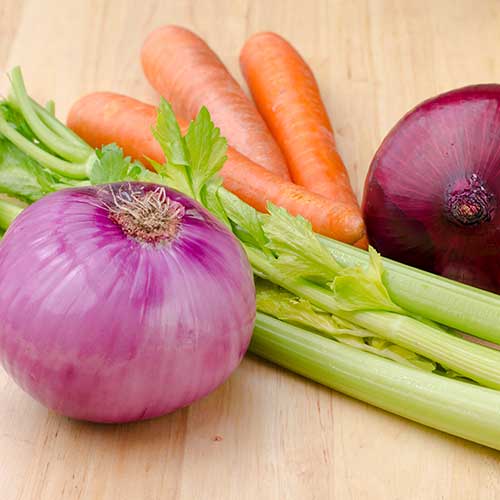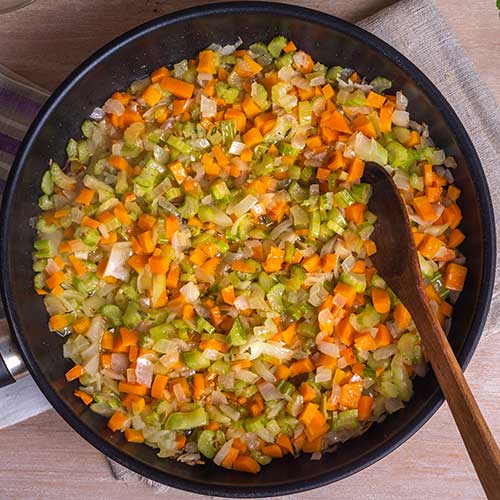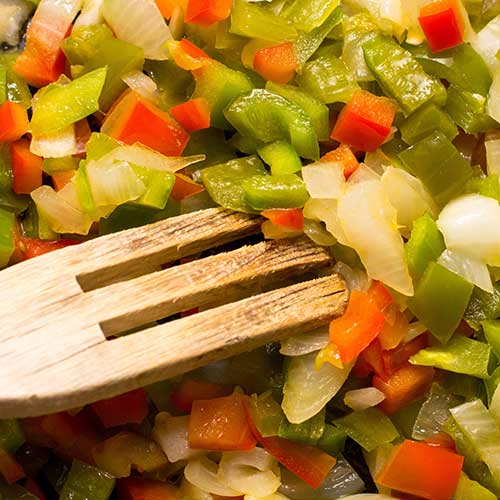What Is Mirepoix?
If you’re studying to become a chef, one of the first lessons you’ll learn in culinary school is how to prepare a mirepoix. This seemingly simple trinity of ingredients packs a flavorful punch in many restaurant recipes. With it being such a fundamental food base, we’ve created a resource to explain how mirepoix is made, what it is used for, and what other types of mirepoix exist in the culinary world.
Shop All DicersWhat Is Mirepoix Base?

Mirepoix is an aromatic blend of ingredients made to bring flavors to foods like stews, soups, stocks, and broth. This trinity food is made by slowly cooking carrot, onion, and celery to “sweat” out the flavor and create a delicious base for other recipes to be built upon. The vegetables are typically strained out of the recipe before the meal is served. It is a staple in French cuisine.
How to Pronounce Mirepoix
The appropriate mirepoix pronunciation is “meer-pwah” and is French in origin.
Mirepoix Origin
Mirepoix was named after Duke Charles-Pierre-Gaston Francois de Levis, the French aristocrat that governed the town of Mirepoix in Ariege, France. This eighteenth-century duke was in the court of King Louis XV and created the aromatic trinity food during his time as chef de cuisine.
How to Make Mirepoix
We have prepared step-by-step directions below to help you learn how to make a mirepoix, along with some tips and tricks on how to adapt mirepoix to your recipe.
Mirepoix Ingredients
Traditional French mirepoix contains four main ingredients:
- Carrot
- Celery
- Onion
- Butter or Oil
Mirepoix Recipe Directions
- Start by peeling your onion and thoroughly washing your carrots and celery so they are perfectly clean.
- Chop your vegetables so you have two parts onion, one part carrot, one part celery. Size the cuts according to your mirepoix ratio and recipe.
- Once you have your mirepoix mis en place, heat your oil or butter on a low heat in a skillet or dutch oven.
- Add the vegetables and cook the vegetables on a medium-low heat for about 10 minutes or until they are soft and translucent. Do not allow the vegetable to brown and caramelize.
- Once translucent, remove the mirepoix vegetables and proceed with the rest of your recipe.
What Is the Ratio of Mirepoix?

The appropriate mirepoix ratio is 2:1:1 with two parts onion, one part carrot, and one part celery. You can measure the ratio based on the weight of the ingredients using a portion scale. If you don't have a scale, you can use measuring cups. Use these measurements as an example: 16 oz. or 2 cups of onion, 8 oz. or 1 cup of carrots, 8 oz. or 1 cup of celery.
Your mirepoix size will depend on what you’re planning to make:
- Small Mirepoix - Cut 1/8 - 1/4 inch pieces. Perfect for sautees and stir-fries.
- Medium Mirepoix - Cut 1/2 - 3/4 inch pieces. Perfect for stews and soups.
- Large Mirepoix - Cut 1 - 2 inch pieces. Perfect for stocks and broths.
Chopping your ingredients relatively the same size allows them to cook evenly and extract the most flavor.
Recipes That Use Mirepoix
If you’re interested in learning how to use mirepoix, the following recipes are a great place to start.
- Chicken Noodle Soup
- Chipotle-Maple Glazed Turkey
- Chicken Fricassee
- Beef Stew
- Meatloaf
- Shrimp Scampi
With these recipes as inspiration, you’ll find many mirepoix uses in your kitchen.
Mirepoix vs Pincage
French pincage is mirepoix with the addition of tomato paste for additional flavor. This mirepoix variation is usually used to make recipes with rich broths, like French demi-glace, Espagnole sauce, and oxtail consomme.
Mirepoix Variations
The traditional French mirepoix blend is just one variation of aromatic bases. Below, we created a list of some different types of mirepoix found in cuisine from around the globe.
1. Cajun Holy Trinity

The Cajun Holy Trinity, also known as Cajun Trinity or just Holy Trinity, is an aromatic base made with onion, celery, and green bell pepper. The Cajun Trinity is used in many Cajun and Creole dishes including jambalaya and gumbo.
Mirepoix vs Trinity
The difference between mirepoix and the holy trinity is that the Cajun Holy Trinity uses green bell pepper instead of carrots. Cajun Trinity and mirepoix both include onions and celery as parts of their ingredients.
2. Italian Soffritto
Italian soffritto is made with minced onion, celery, and carrot heated in olive oil. Fresh herbs like parsley, garlic, and fennel are regularly added to the aromatic blend. Some chefs may even add a cured meat, like pancetta or prosciutto, to amplify the flavor. Italian soffritto is often used to make minestrone soup, pasta e Ceci, and Italian wedding soup.
Soffritto vs Mirepoix
The difference between mirepoix and soffritto is that soffritto uses minced vegetables instead of diced and must be cooked in olive oil. The Italian soffritto may also feature herbs while mirepoix does not.
3. Spanish Sofrito
Spanish sofrito, also known as Latin sofrito, is made with onion, tomatoes, bell peppers, and garlic. The vegetables are gently fried with herbs and olive oil. Spanish sofrito is the base for many Latin dishes, including paella, sancocho, and rice-and-bean dishes.
Sofrito vs Mirepoix
The difference between sofrito and mirepoix is that sofrito uses tomatoes, bell pepper, and garlic while mirepoix does not. Sofrito is also fried in olive oil while mirepoix is traditionally slowly cooked in butter. You can also expect to find herbs added to sofrito but not in mirepoix.
4. German Suppengrun
German suppengrun, translating to “soup greens”, is made with carrots, celeriac (celery root), and leeks. Herbs, like parsley and thyme, and root vegetables like rutabaga and onions are often added to this aromatic base. Due to cold German winters, the ingredients in suppengrun are hearty and have long shelf lives. Suppengrun is used to make Fuhrmannsbraten (braised beef roast), potato soup, and Sauerbraten (German-style oxtail soup).
Mirepoix vs Suppengrun
The difference between mirepoix and suppengrun is that suppengrun uses celery root instead of celery stalks and leeks. Both aromatic bases use carrots and are used as bases for soups and stocks.
5. Chinese Aromatics
Although there are many Asian aromatic combinations, many Cantonese dishes are made with a Chinese aromatic blend that contains scallions, ginger, and garlic. These ingredients are cooked in oil and are used to make a variety of lo mein noodle and stir-fry dishes.
Mirepoix vs Chinese Aromatics
The difference between mirepoix and Chinese aromatics is that most Chinese aromatics incorporate umami and heat-building ingredients like ginger, garlic, and scallions, while mirepoix uses more subtle flavors of carrot, onion, and celery.
6. Indian Aromatics
One variation of Indian aromatics is made by cooking onions, garlic, and chilies in ghee. Ginger is often added to this regional aromatic trinity. This Indian mirepoix equivalent is used to make traditional curry dishes.
Mirepoix vs Indian Aromatics
The difference between mirepoix and Indian aromatics is that Indian aromatics are used to add spice and heat to curry dishes, while French mirepoix ingredients are mild and savory flavors.
Mirepoix FAQs
What Are Aromatics in Cooking?

In the culinary world, aromatics are ingredients used at the beginning of a recipe to incorporate richer flavor in the dish. These vegetables or herbs are usually heated in oil or butter and may be removed before the cooking process is complete.
Can You Freeze Mirepoix?
You can certainly freeze your mirepoix ingredients to save time in the kitchen. You can chop the ingredients ahead of time or freeze the remaining vegetables while preparing a recipe. Frozen mirepoix, once thawed, may have a softer texture than using fresh mirepoix so it's best for soup recipes.
What Do You Cook First, Mirepoix or Meat?
There is no strict rule for when you should prepare your mirepoix in the process of your recipe. However, most recipes will have you sear the meat first so that the mirepoix can cook in the residual fat for a more savory flavor.
What Happens to the Mirepoix after Cooking?
When you are finished extracting the flavor from your mirepoix, you can strain it out of the pan and dispose of it. If you are looking for more sustainable practices than just trashing your spent mirepoix, you can try some of these alternatives.
- Compost it
- Blend it to thicken gravy
- Add it to the mix for making veggie burgers
- Blitz it and add it to mashed potato recipes
Mirepoix is a cornerstone in the culinary world, making it an essential skill to learn in your kitchen. Enjoy regional variation in your recipes to liven up your menu and create dishes that will have your customers coming back for more.








